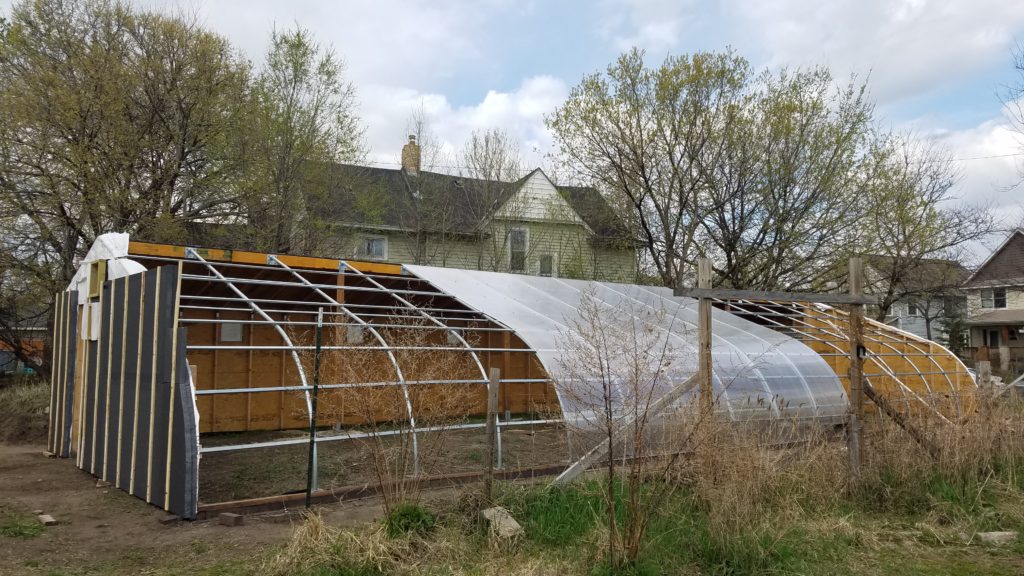By ELIZA SCHOLL, HECUA INTERN WITH TAMALES Y BICICLETAS


On South 15th Avenue, half a block south of E. 28th St., Tamales y Bicicletas is building a winter greenhouse on its urban garden space. For ten years, the nonprofit has used bikes and urban farming to reduce the environmental impacts of the heavy concentration of industry on the East Phillips community.
“How do we decolonize our food systems that then leads to decolonizing our minds and bodies?” asks Jose Luis Villaseñor Rangel, the founder of Tamales y Bicicletas. That’s always been the DNA of why we do what we do.”
The construction of a winter greenhouse is Tamales y Bicicletas’ latest project. Daniel Handeen, a professor of architecture and a Research Fellow at the Center for Sustainable Building Research at the University of Minnesota who designed this greenhouse model, was looking for a way to grow crops through the winter with minimal additional heating inputs. The goal was to generate as little carbon dioxide output as possible. Handeen’s design is being constructed by Tamales y Bicicletas and by Appetite for Change on Minneapolis’ north side.
Handeen and Villaseñor affix glazing. The flexible plastic is double walled and will let sun in without letting as much heat out as traditional greenhouse plastics. Photos: Jessie Merriam
“The project came from all the peripheral issues about food insecurity and food justice. We didn’t want to have to rely on drought-prone Valley Central crops being brought in. We wanted to be able to provide for ourselves, regionally and locally,” explains Handeen.
This farm scale greenhouse emerged from the Version 2 deep winter greenhouse model trying to make a more accessible version in terms of cost, constructability, and space. This greenhouse is cheaper per square foot than its predecessor. It will have enough insulation to allow plants to grow through the winter without relying on heating systems or expensive lights. Handeen and other researchers will put sensors in the finished greenhouse to monitor how well the greenhouse design is able to stabilize temperature.
Handeen emphasizes that the greenhouse, which will be powered by solar energy, will allow people to plant in the soil even during cold Minnesota winters. Most Minnesota greens that people find in co-ops during the winter rely on hydroponic growing systems, says Handeen. Typically, growing food in the winter requires growing inside with big horizontal lights, but growing in the ground in the deep winter greenhouse helps us to maintain our relationship with the earth, as Villaseñor puts it.

In other parts of the state, like at the Lake City Catholic Worker Farm, farmers using the initial deep winter greenhouse have even been able to grow citrus fruits and perennials. These crops are pollinator-friendly, providing a place for bees that come out of dormancy in the early spring to eat.
“I’m really excited about exploring the possibilities of the micro-climate that’s present inside the greenhouses,” says Handeen.
Minneapolis city government has financed half of the costs of construction as part of its commitment to working with the community on food security. Forty percent of costs have been covered by a Dannon Yogurt grant, and another ten percent by Tamales y Bicicletas. Most of the construction has been done by volunteers.
“There was a moment where urban farming was its own thing, just radical folks,” says Villaseñor. The conversation around food justice has evolved to the point where the City has shown support for getting nutritious food to the community, from urban farm initiatives to pushing corner stores to stock fresh food. Villaseñor appreciates the investments the City is making to promote food security.
This greenhouse has long been a dream for Villaseñor: “Before COVID we were planning relationships with small restaurants. How do we keep this going over the winter? How do we start our own plant starts early, so the community can have that at hand when it’s time to transplant? We could have a greenhouse.”
Ultimately, Tamales y Bicicletas hopes the greenhouse will be a place for community members to grow free food and sell some food to local restaurants to sustain the project. Along with growing food, this greenhouse is meant to be a space for community conversations and building solidarity within the East Phillips community.
When the greenhouse construction is complete, plots will be available for people who live along 14th or 15th Avenue in East Phillips to farm. Flyers will be posted in the neighborhood announcing a time to sign up for plots when the greenhouse is ready.

If interested in growing food with
Tamales y Bicicletas, you can reach out
to Ashley Satorius at
ashley@tamalesybicicletas.org
or learn more about the organization at
http://tamalesybicicletas.weebly.com /.
Those interested in making a donation
can navigate to the website and select
the yellow “donate” button.
VOLUNTEER WITH THE GREENHOUSE: all skill levels welcome (moving soil, weeding, building, plumbing, electrical work, and general community support welcome! Contact Jessie at jmerriam@spa.edu











